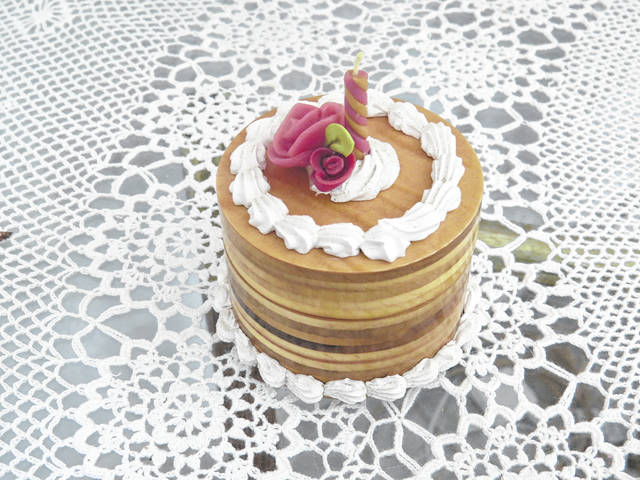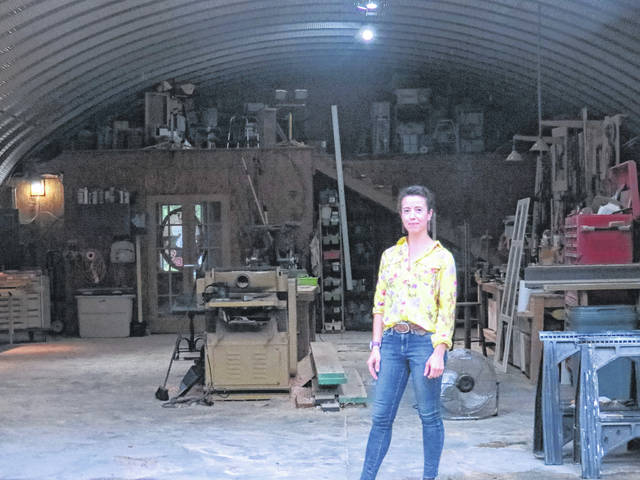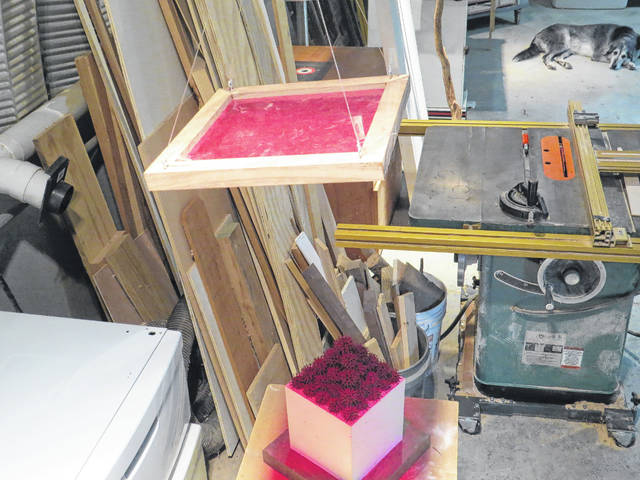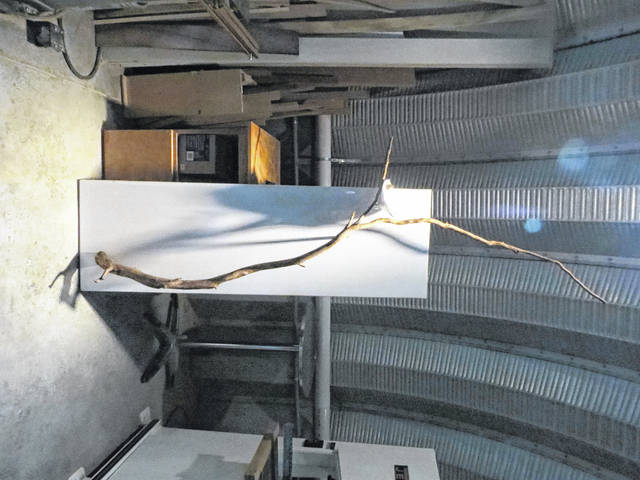ROCKINGHAM — Her time at Richmond Senior High School may not have been the best of her life — she was a “weird kid” — but April Harmon returned to Rockingham anyway and found it an oasis.
She comes back about every four years to her parents’ property on Sandhill Road, dragged by a nagging backlog of ideas for new art pieces.
“Something about Rockingham has a gravity to it,” Harmon says. “You can catch your breath here.”
Harmon is a creator with many muses: sheet metal, a particular stick from the woods, cake, gelato, space, resources.
Nothing is wasted. All is inspiration for the next idea.
She composts to feed her garden, has stored an entire barrel of rainwater and is working on a system to recycle her gray water.
Her efficiency forged in her time as a production manager, Harmon figures that she really needs only the 20-by-8-foot space that comprises her kitchen and dining room to be comfortable — “I’d rather be outside,” she says — and is always plotting her eventual transition into a “tiny house,” meaning a do-it-yourself minimalist home she can carry on a trailer to wherever her work takes her without having to worry about soaring housing costs on top of her student loans.
“It’s always been my dream to build my own house.”
Harmon graduated from Fayetteville State University with an art degree at the height of the 2008 financial crisis and counts herself lucky she was rejected from graduate school, which allowed her to avoid incurring even more debt. She can look back on that time with a laugh these days, and has been planning her tiny house for five years now.
Harmon is about five months into her current stint in Rockingham but plans to stay only until she finishes her tiny house, however long that takes.
“I don’t like permanence,” she says.
Until then, she’s working full time for a framer in Pinehurst and attending to the “million and one” home- improvement tasks she has going on at any given time, which she keeps track of on four lists separated by importance. Her strategy is simply to “do what you can when you can with what you’ve got.”
The central feature on her property is an air hangar-shaped workshop that opens like a braced-faced smile greeting one at the end of her driveway.
It’s messy, but there’s an order to it. Two unfinished projects occupy the cleaner side, but many more works in progress can’t be seen. One, a cube with a sweet gum ball pyramid on top, is given a sinister hue by red glass that dangles under a light above it. It comes with two names: the safe one, “Perspectives,” and the one she really wants: “The House That Pain Built.”
Holes punctuate the cube where air bubbles formed in the plaster cast, imperfections Harmon came to embrace.
“I like ‘em,” she says. “You can tell it’s plaster.”
The other project, a long curving stick with a metallic flower resting in the fork, is her “self portrait.” It originally was going to be a simple wall piece that would hang over a bed or couch horizontally, but an “epiphany” made Harmon turn it vertical, no longer an accessory.
On first glance, it’s too simple, perhaps frustratingly so, but look closer and you’ll see an intricate pattern cut into the wood — so fine that it can’t have been done by a human hand. Nature did it — termites, or something else.
Harmon’s family moved from Portland, Oregon to the house she’s in now when Harmon was 12. Years later, her parents bought the adjoining property, connected by a strip of land around the neighboring property.
Her father built the shop to support his furniture-building hobby, and at some point, Harmon picked up the obsession for herself.
“I make everything,” she says. “It’s exhausting.
“I have a very specific vision for things, so if I can’t find what I want I’ll just make it.”
When she was young she made all her clothes, which she says was at least part of what made her one of the weird kids in school. She makes jewelry and Halloween costumes for her dog, Kiska. The latest costume she made for Kiska was of Po from the animated movie Kung-Fu Panda.
Since college, Harmon has moved around and worked a series of jobs that allowed her to keep some amount of creativity in her work: she baked and decorated cakes at a shop in Alaska, managed a gelato factory in Hawaii, and worked as pastry chef and, later, a carpenter for an artist in New York. The artist would give her sketches of what he needed in terms of a canvas and she would prepare the materials, sanding them down so the medium could disappear into the piece.
“It takes a lot of sanding to make it look like no one’s touched it,” she says.
Now she has combined these skills by making miniature wooden cakes with all the flowery decorations; they can store jewelry inside.
Harmon says she actually swore off art after college, perhaps thinking it something working adults can’t or shouldn’t have time for, but always found herself making things — even woodworking with noisy power tools in her tiny New York apartment, which her neighbors surely enjoyed.
Her comfort in the town that once made her feel like an outcast perhaps would not be possible if she hadn’t ventured to the far reaches of the country to Alaska.
“Alaska taught me to look around,” she says. “Nature slaps you in the face everywhere you look up there. “I’ve always been the little girl outside playing in the dirt.”
Her time in Alaska rekindled that wonder and made nature inseparable from her artistic expressions.
She walks through the woods around her house, looking for something in a tree branch that inspires her and produces it, filling notebooks with sketches and snippets that seed the next project.
Things that are unremarkable to the lifelong resident, such as the sweet gum balls on “The House That Pain Built,” contain a world of meaning to Harmon, who comes to them like a stranger. To her, the sweet gum balls aren’t just the annoying — sometimes dangerous — spikes that litter her yard; they are an alien formation she discovered as a child and that since have defined “home.”
Her totems of the South — mint juleps, apple pie, unique plant and animal life — fill in her down time.
A new bird she had never seen with a brilliant, almost neon-blue plumage, was flying around her yard and she was determined to snap a picture and find out what it was. Finally she caught a picture and sent it around to friends and family, looking for help to identify it.
It was no blue jay but an indigo bunting, which, according to “All About Birds,” is found in the Eastern United States during mating season.
“Moving around made me appreciate where I am,” Harmon says. “It makes it easier to enjoy a place if you’re always looking for new things, (and) I’m easily amused.”
Does all this self-expression, moving from place to place creating have a “point”?
What does success look like when you live this kind of life?
“Success, for me, is having my work be self-perpetuating,” Harmon says. “It leads me to new collaborations, new ideas — things I’ve never thought of before.”




